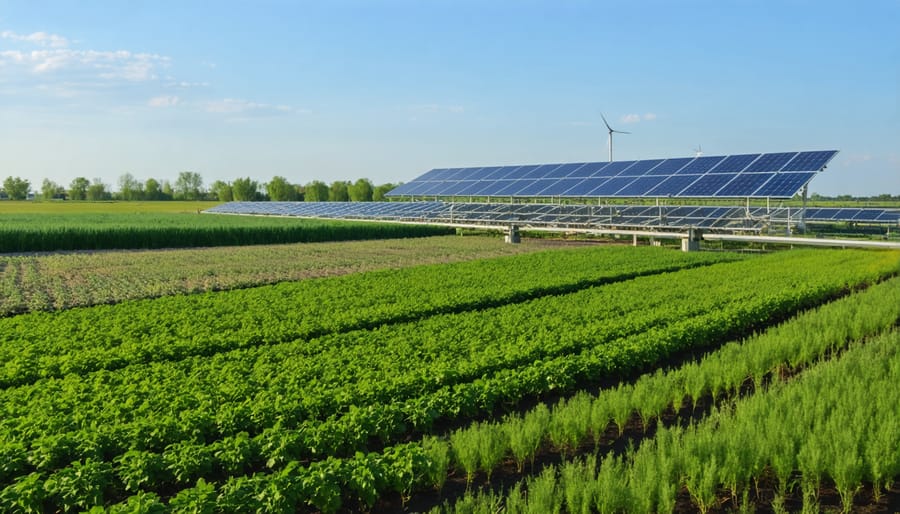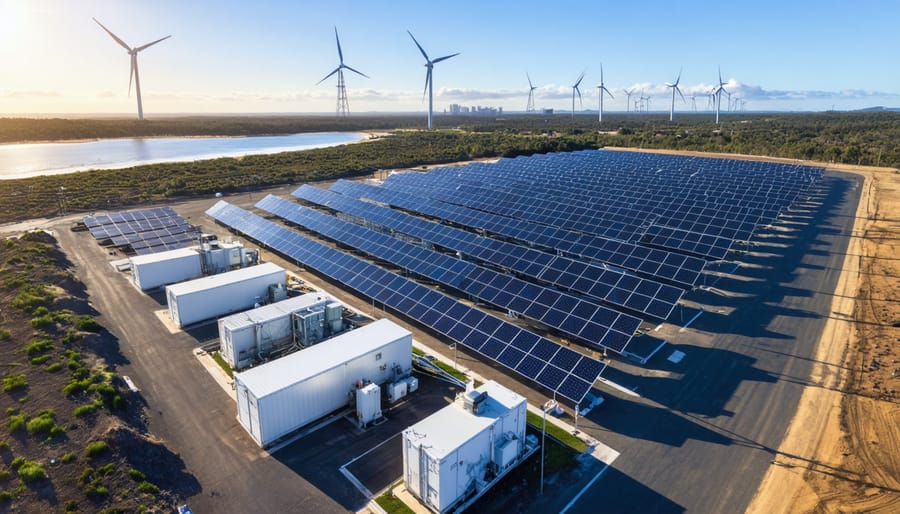# Adaptive Markets Hypothesis: The Key to Future-Ready Energy Regulation
Australia’s energy landscape is transforming at breakneck speed. Solar farms bloom across the outback, wind turbines line our coasts, and bioenergy projects convert agricultural waste into power—yet our regulatory frameworks remain stubbornly rooted in the fossil fuel era. This mismatch between dynamic markets and static rules is costing us billions and slowing our renewable transition.
Enter the Adaptive Markets Hypothesis (AMH), a groundbreaking financial theory that’s revolutionizing how we think about regulation. Unlike traditional economic models that assume markets reach perfect equilibrium, AMH recognizes that markets evolve like biological ecosystems—constantly adapting to changing conditions, learning from experience, and responding to environmental pressures.
For Australia’s energy sector, this insight is transformative. Just as successful investors adjust their strategies when markets shift, effective energy regulation must flex and respond as renewable technologies mature, storage solutions improve, and consumer behaviors change. The AMH framework offers policymakers a practical roadmap for creating regulatory systems that encourage innovation rather than stifle it.
Consider South Australia’s journey: when the state experienced its controversial 2016 blackout, adaptive regulatory responses—including the world’s largest lithium-ion battery installation—turned crisis into opportunity. This wasn’t rigid rule-following; it was evolutionary problem-solving in action.
This article explores how AMH principles can guide Australia’s energy regulators through unprecedented change, with particular focus on emerging bioenergy opportunities. We’ll examine real-world success stories, identify practical regulatory adjustments, and demonstrate why thinking like an ecosystem—rather than a static system—is essential for achieving our renewable energy targets while maintaining grid reliability and affordability.
The future of energy regulation isn’t about perfect plans—it’s about smart adaptation.
What the Adaptive Markets Hypothesis Actually Means

From Wall Street to Power Grids
The principles that explain why stock markets swing between boom and bust aren’t confined to trading floors—they’re equally powerful when applied to Australia’s energy transformation. Just as financial traders must constantly adapt their strategies to changing market conditions, our energy systems now face an unprecedented need for flexibility as renewable sources reshape the grid.
Traditional energy markets operated like clockwork: coal plants produced steady, predictable power, and regulations reflected that stability. But the rise of solar farms, wind turbines, and emerging bioenergy facilities has introduced beautiful complexity. The sun doesn’t always shine, the wind doesn’t always blow, and agricultural waste from Queensland’s sugar cane harvest arrives seasonally—yet demand for electricity continues round the clock.
This is where adaptive thinking becomes essential. Financial markets taught us that rigid rules eventually break when faced with constant change. The same holds true for energy regulation. A fixed regulatory framework designed for yesterday’s coal-dominated grid simply can’t accommodate today’s dynamic mix of renewable sources without creating bottlenecks and inefficiencies.
Consider South Australia’s journey: when renewable energy first surged into their grid, static regulations struggled to keep pace. Success came through adaptive approaches—regulations that could flex with changing conditions, much like savvy investors adjusting their portfolios. This adaptive mindset isn’t just theory; it’s the practical foundation for integrating diverse renewable sources, including bioenergy from agricultural and forestry waste, into a reliable, sustainable energy future for all Australians.
Why Australia’s Energy Markets Need to Evolve (And Fast)
The Renewable Energy Rollercoaster
Australia’s renewable energy landscape is anything but static—it’s a genuine rollercoaster of supply and demand that changes by the hour, the season, and even the weather forecast. Solar panels produce abundantly during summer days but offer little during winter evenings when families return home and flick on their lights. Wind farms generate powerfully when fronts sweep across the continent, then sometimes fall silent for days. This unpredictability creates a fascinating challenge that traditional regulatory frameworks, designed for steady coal-fired power stations, simply weren’t built to handle.
Here’s where bioenergy becomes the unsung hero of the renewable transition. Unlike solar and wind, bioenergy facilities can provide reliable baseload power around the clock, using agricultural waste, forestry residues, and organic materials that would otherwise decompose and release greenhouse gases anyway. Queensland’s sugar mills, for instance, have successfully demonstrated how bagasse—the fibrous residue from sugarcane—can power operations continuously while feeding excess electricity into the grid when demand peaks.
The adaptive markets hypothesis suggests that just as financial markets evolve with changing conditions, energy regulations must flex and respond to these distinct characteristics of different renewable sources. A one-size-fits-all approach simply won’t work when solar needs different grid integration strategies than bioenergy. Progressive decentralized energy systems are already proving this concept, particularly in rural communities where local bioenergy facilities provide stability while complementing intermittent solar and wind.
Smart regulations need to recognize these differences, rewarding baseload reliability while incentivizing variable renewables appropriately. This dynamic approach ensures Australia’s energy transition remains both ambitious and achievable.

Adaptive Regulation: Making Rules That Learn
Real-Time Adjustments vs. Rigid Rulebooks
Traditional energy regulation has typically operated like a rigid rulebook—set parameters, fixed timeframes, and infrequent reviews. Think of it as trying to navigate Australia’s unpredictable weather with last year’s forecast. When renewable energy sources like bioenergy enter the mix, these inflexible approaches struggle to keep pace with rapidly changing market conditions.
Adaptive regulation flips this approach on its head. Rather than waiting for annual policy reviews or relying on outdated benchmarks, adaptive models use real-time data to trigger automatic adjustments. Imagine a regulatory system that monitors grid stability, renewable energy output, and demand patterns constantly—then automatically fine-tunes incentives, tariffs, or grid access rules when specific thresholds are met. This is where market-based pricing mechanisms become truly dynamic.
South Australia’s experience with renewable energy integration demonstrates this brilliantly. During periods of high solar generation, adaptive systems can automatically adjust feed-in tariffs or storage incentives to prevent grid overload—all without bureaucratic delays. Similarly, when biomass plants demonstrate consistent baseload capacity, data-driven regulatory adjustments can expedite grid access approvals or modify renewable energy certificates.
The beauty of this approach lies in its responsiveness. Instead of biomass producers navigating red tape for months, adaptive frameworks recognize performance metrics in real-time and respond accordingly. Queensland’s agricultural waste-to-energy projects have particularly benefited from pilot programs using automated threshold systems that reward consistent renewable generation with streamlined compliance processes.
This shift doesn’t mean abandoning oversight—it means creating smarter, more responsive regulations that evolve alongside our energy landscape, ensuring renewable technologies like bioenergy can flourish without unnecessary barriers.
Success Stories: Where Adaptive Energy Regulation Is Working
The proof is in the pudding, as they say, and adaptive energy regulation is already delivering impressive results around the world. Let’s explore how flexible, responsive regulatory frameworks are transforming energy markets and paving the way for a cleaner future.
**Denmark’s Wind Revolution Through Adaptive Grid Management**
Denmark has become a global leader in renewable energy by embracing adaptive regulation that evolves alongside market conditions. Rather than locking in rigid targets decades in advance, Danish regulators created a framework that adjusts grid connection rules, feed-in tariff structures, and balancing requirements based on real-time renewable penetration levels.
The results speak volumes. Denmark now regularly generates more than 80% of its electricity from wind power on particularly blustery days, with sophisticated adaptive pricing mechanisms that encourage consumption when renewables are abundant and discourage it during scarcity. Their regulatory approach allowed wind operators to gradually take on more grid responsibility as the technology matured, rather than imposing burdensome requirements from day one that might have stifled early adoption.
The Danish model demonstrates that regulations can be both ambitious and flexible. Grid reliability has actually improved despite the intermittent nature of wind power, and Danish consumers benefit from some of Europe’s cleanest electricity. The key was creating regulatory guardrails that could shift and adapt rather than rigid walls that might crack under pressure.
**South Australia’s Battery Storage Success**
Closer to home, South Australia has shown how adaptive thinking can solve real-world energy challenges. Following statewide blackouts in 2016, regulators worked collaboratively with industry to rapidly deploy the world’s largest lithium-ion battery near Jamestown. Rather than adhering to traditional procurement timelines that could have taken years, regulators adapted approval processes and grid connection requirements to accelerate deployment.
The Hornsdale Power Reserve came online in just 100 days and has since saved consumers millions of dollars while stabilizing the grid during peak demand. South Australia’s willingness to adapt regulatory frameworks to accommodate emerging storage technology created an environment where innovation could flourish quickly. The state now boasts some of Australia’s highest renewable energy penetration rates, proving that regulatory flexibility and grid stability aren’t mutually exclusive.
**Germany’s Bioenergy Village Revolution**
Germany’s “Bioenergy Village” program demonstrates adaptive regulation supporting agricultural communities. Recognizing that rural areas had unique opportunities for biomass generation, German regulators created tailored frameworks allowing farming communities to develop localised bioenergy systems using agricultural waste and energy crops.
Villages like Jühnde transformed themselves into energy-positive communities, generating heat and electricity from locally sourced biomass. The regulatory approach adapted to community scale, recognizing that small-scale bioenergy operations needed different rules than large industrial facilities. This flexibility encouraged over 140 villages to pursue bioenergy independence, creating rural jobs while reducing emissions.
These success stories share a common thread: regulators who listened, learned, and adapted their approaches based on emerging evidence and changing market conditions. They prove that when regulation evolves alongside technology and market realities, everyone benefits—consumers, industry, and the environment alike.

Building Adaptive Markets for Bioenergy in Australia
Creating Fair Competition Between Energy Sources
Traditional energy markets have long favoured fossil fuels through established infrastructure, subsidies, and regulatory frameworks that weren’t designed with renewables in mind. The adaptive markets hypothesis offers a pathway to creating genuine competition where all energy sources—including bioenergy—can compete based on their actual value to the grid and society.
The key lies in recognising that different energy sources bring unique strengths to the table. While solar and wind provide clean electricity when conditions are right, bioenergy offers something equally valuable: dispatchable power that fills gaps when the sun isn’t shining and the wind isn’t blowing. Rather than treating all renewables identically, adaptive frameworks can reward each source for its specific contribution to grid stability and reliability.
Australia’s experience with wholesale electricity markets demonstrates this potential. Some forward-thinking states are beginning to value “firming capacity”—the ability to generate power on demand—alongside raw generation. This creates natural opportunities for bioenergy from agricultural waste and forestry residues to shine, particularly in regional areas where biomass resources are abundant.
Renewable energy investment decisions become more balanced when regulations acknowledge the full picture. For instance, a sugarcane region’s bagasse-fired plant might receive credit not just for producing renewable electricity, but also for providing local energy security during cyclone season when transmission lines often fail.
The beauty of adaptive frameworks is their flexibility to evolve as technology advances and market conditions shift. This means bioenergy isn’t locked into today’s economics—it can benefit from innovations in gasification, anaerobic digestion, and other conversion technologies as they mature, creating fair dinkum competition that serves Australia’s transition to clean energy.
What This Means for Everyday Australians
For households across Australia, adaptive regulation in energy markets translates into real benefits you’ll notice in your electricity bills and local communities. When regulatory frameworks can quickly respond to market changes—much like investors adapt their strategies—the renewable energy transition becomes smoother and more affordable for everyone.
The most immediate impact? More stable electricity prices. Traditional rigid regulations often create bottlenecks that drive up costs when new technologies emerge. Adaptive frameworks, however, allow renewable energy sources like bioenergy to integrate seamlessly into the grid, reducing the price volatility that’s frustrated Australian families for years. Think of it as your energy market learning and improving, rather than being stuck in outdated patterns.
Regional Australians stand to gain considerably. Community bioenergy projects that once faced months or years of regulatory hurdles can now move forward faster. This means towns from the Riverina to Far North Queensland can transform local agricultural waste into clean energy—creating jobs right where they’re needed most. One council in regional Victoria reported that streamlined approval processes helped their biomass facility begin operations eight months earlier than anticipated, employing 23 locals immediately.
For those working in or investing in renewable energy, adaptive regulation provides the confidence needed to commit resources. When regulations can evolve alongside technology, investors see reduced risk, leading to increased funding for innovative projects. This creates a positive cycle: more investment means more projects, which means more jobs—from construction and engineering to ongoing operations and maintenance.
The beauty of this approach is that it doesn’t pick winners or losers; it creates conditions where the most effective solutions naturally emerge, benefiting communities with cleaner air, reliable energy, and genuine economic opportunities that stay local.

Australia stands at a pivotal crossroads in its energy journey. The transition to renewable energy isn’t just happening—it’s accelerating at a pace our current regulatory frameworks weren’t designed to handle. The adaptive markets hypothesis offers us a powerful lens through which to reimagine how we govern this transformation, recognising that energy markets, like financial markets, are living systems that evolve, learn, and adapt to new information and technologies.
The success stories emerging across Queensland, New South Wales, and Victoria demonstrate what’s possible when regulation embraces flexibility rather than rigidity. From sugarcane bagasse powering regional communities to innovative grid-scale battery storage solutions, these examples prove that adaptive regulation isn’t theoretical—it’s practical, achievable, and urgently needed.
The opportunity before us is substantial. By creating regulatory frameworks that can pivot as quickly as technology advances, we can unlock billions in renewable energy investment, create thousands of regional jobs, and position Australia as a global leader in the clean energy transition. Adaptive regulation means bioenergy projects can scale faster, grid integration challenges can be solved more creatively, and innovative business models can flourish without being strangled by outdated rules.
But this transformation won’t happen on its own. Whether you’re a policymaker drafting new legislation, an industry professional navigating market complexities, or a concerned citizen passionate about Australia’s energy future, your voice matters. Now is the time to advocate for smarter, more responsive energy market rules. Champion pilot programs in your community. Support regulatory sandboxes that test new approaches. Engage with consultation processes. Push for evidence-based policy that learns from what works and adapts what doesn’t.
The future of Australia’s energy system depends on our willingness to embrace change today.

